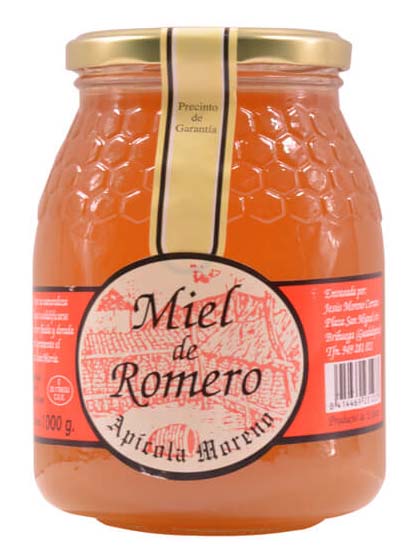Properties of rosemary
Rosemary is a typical plant of the Mediterranean climate with enormous medicinal properties of which the man takes advantage to elaborate great quantity of plates and the bees to elaborate his raw honey. keep reading and learn about the properties of rosemary.
In El Cortijuelo de San Benito in Las Rozas de Madrid or in our online store you can buy a wide variety of products with rosemary, such as: rosemary honey, shampoos, cheeses with rosemary and olives with rosemary aroma.
If you are interested in the properties of other medicinal plants, you may be interested in: Properties of thyme
Scientific name
Rosmarinus officinalis L.
Description of rosemary as a shrub
Rosemary is a plant between 0.5 to 1 meter high, although it can reach up to two meters in height. Rosemary stays green all year round.
Its youngest stems have a square shape but with their ageing they become round and with cracked bark. Its leaves that at birth come out facing each other, at maturity take between 2 to 3 cm long and about 3 mm wide with their edges that curve downwards. The beam of these sheets has an intense green color and its reverse takes a white color due to a thick tomento that covers its reverse.
By the peduncle of the leaves, that is to say the small taño that joins the trunk with the leaf small bouquets of purple flowers or pale blue are born. Each flower about 5 mm long is composed of a calyx and corolla bilabiate pale blue or purple with small elongated purple spots. The rosemary flower has two stamens in a curved shape very close to the anthers. The rosemary flower and its leaves are very aromatic and somewhat spicy.
Characteristics of rosemary
Flowering of rosemary:
Rosemary is a plant that begins its flowering in early spring and if its growing conditions are favorable, the flowering extends until autumn.
Where rosemary grows
Rosemary can be found on slopes and lowland hills. This plant likes calcareous soils and is usually found in areas with holm oaks, rockroses, thyme and lavender. Rosemary is a typical Mediterranean plant that we often see throughout the south, center and east of the Iberian Peninsula, from coastal altitudes to 1500 meters and more rarely in northern Spain.
Composition of rosemary
Rosemary leaves contain tannins, acid saponin, glucoside, the latter in very small quantities and resins. However, the most interesting component we find in rosemary is its essence, which depends on the area where it grows and the time of year. Its proportion is usually between 12 and 2%, being a colorless liquid and sometimes with yellowish notes that give the typical flavor of rosemary.
The essence of rosemary is basically made up of α-pineno, canfeno, cineol, camphor of rosemary and borneol and the proportion of these components depends on the area and the time of year.
Magical properties of rosemary
Rosemary is one of the plants with the greatest benefits that we have in the Mediterranean area, but we will summarize here the most important: stimulant capacity. is something diuretic and antispasmodic and regulates bile secretion.
It also acts favorably on the whole vasomotor nervous system of the body, and what makes it more interesting, acts very positively on the nerves of the heart.
Uses of rosemary:
Rosemary is an herb that should be in any kitchen for use as a condiment, always giving a fine smell and taste to foods. The cooks recommend rosemary to season sauces and roasts, fish and is even widely used in vegan and vegetarian cuisine.
Rosemary honey:
One of the most appreciated honeys by the Spaniards is rosemary honey. Rosemary honey
Rosemary honey has a clear amber color that when crystallized if it does not have any contamination of myelates takes a very white color. In the mouth you can appreciate its very soft taste and camphorous taste, especially if not contaminated by other flowers.
The granulometry of rosemary honey is fine unless it has parts of almond honey that makes its crystallization thicker.

Photo 1: Rosemary honey
History of rosemary:
Rosemary has been known for centuries for its rejuvenating properties and has been used for centuries everywhere, from culinary to curative purposes.
Properties of rosemary for hair
If after washing the hair, we pour an infusion of honey with rosemary, it will leave the hair much healthier and more shiny.
Sources:
Plantas Medicinales. El Discórides renovado. Editorial Labor, S.A. Barcelona 1987
El pequeño doctor, consejos útiles para mejorar la salud. A. Vogel. Editorial ARS Medica S.A. Barcelona. 1986
Properties of rosemary. medical news today







Leave a Reply
Want to join the discussion?Feel free to contribute!